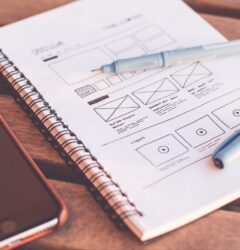The Complete Guide to Writing Up a Successful UX Proposal
13 Dec

Table of Contents
ToggleWhether you’re working on a website, network, product, or service, the user experience you provide is one of the most important considerations you need to be thinking about.
A UX proposal is the process and plan of how to change, upgrade, or improve the said experience.
Within a successful proposal, everybody involved in the project will be able to know exactly what’s going on, and all departments can effectively cross-communicate to ensure that everything is carried out and processed efficiently and to the highest quality with minimal risk of mistake.
Even this alone shows the importance of a successful UX proposal, by how exactly do you go about doing this? Today, we’re going to explore everything you need to know about writing a comprehensive UX proposal, providing you with a complete guide to make sure you get it the right first time.
When is a UX Proposal Required?
Typically, a UX proposal will be used to address a problem or to improve a certain feature that ultimately enhances the user’s final experience. For example, you may have a navigation bar on your website or a switch on one of your products.
However, once you’ve identified a problem and plan to take a chance, make sure you don’t jump straight into writing a proposal. Firstly, you’ll want to make sure everyone’s onboard, the idea is cleared with the appropriate people and managers, and the business conditions are right in terms of time and money.
Writing a proposal can be a time-consuming venture when done properly, so you’ll want to make sure you’re not wasting your time writing a proposal that doesn’t need to be written. When you’ve identified a problem and been given the green light, then you can start writing.
Defining the Purpose
The first thing you want to when writing your proposal is making sure that the outcome is clearly defined. This is so everybody involved in the project is on the same page, and there’s no doubt on why the project is happening and what the end goal is.
“In some cases, you may need to research this to see whether there’s a problem. If you’re testing your website, you may need to interview testers and users to see whether there’s a problem in the first place, or you may need to run experiments, such as A/B testing,” — Mary Gooch, a designer at Boomessays.
Research & Details
Once the issue has been identified, and your goals are clearly set, it’s always a good idea to add this information to the beginning of your proposal. This way, if someone new is to join the project in the future and needs to understand where the problem has arisen from, they can simply refer to this section.

Structuring Your Proposal
Next, before you jump into the actual writing and adding the details of your proposal, you’ll want to think about how you’re going to structure your proposal. Doing this early will save you time later on since you won’t have to keep moving things around.
For this, make sure every section is broken down into a clearly-labeled area where anybody will be able to find what they’re looking for with ease. Working in chronological order is a fair way to approach this, but it’s completely up to you.
As an example, you may follow this structure;
- Contents
- Introduction
- Goals of the project
- History of the proposed element of change
- The process
- Departmental information
- The final project
- Admin process
- Deadlines & Budget
- Notes
Of course, what you include in your structure will solely depend on what your proposal is and what you set out to achieve, and you may like to add and take things away as you see fit. You’ll also want to make sure your proposal is accurate now and as you write it.
Here are some writing tools that can help you create a successful UX proposal;
These two online resources are ideal for researching grammar and making sure your knowledge is up to date.
Use these online proofreading tools to make sure your content is error-free, as reviewed by the Australian Reviewer.
These are two writing blogs that you can read for information on how to improve your writing skills and technique.
These two online tools are ideal for editing your UX proposal, guaranteeing a high level of readability.
Use these online writing guides to improve your writing skills for a more comprehensive UX proposal.
Highlight the End Goal
Perhaps you’re improving a feature on your website to boost sales or allow people to navigate your website easier which will hopefully improve the amount of time people are going to stay on your website.
Whatever it is you’re trying to achieve, you need to ensure this is outlined in your proposal. This is important since you’ll need to be able to track the success of your project to ensure it was a success, the desired outcome was met, and you can evaluate the process to improve it next time.
Explaining the Final Product(s)
While you want to be able to track the end goal of the project to see what benefits the improvement will make to your business, product, or service, you will obviously also need to highlight the actual changes you’re going to be implemented on a physical level.
This section should include what the UX element is going to change, what each department or team member needs to be produced, and what steps need to be taken to fulfill these changes and improvements.
The more detail you can include in this section, the more beneficial your proposal will be since there’s such little room for error. However, this will only be the case if you make sure that each department is present and providing input into this section.
Generating Assumptions
The assumptions section of your proposal is perhaps one of the most important yet remains one of the vaguest. This area details situations and events that could occur during the duration of the project, but there’s no proof that it will do so, although it’s simply keeping you prepared for the worst-case scenario.
“An example of a good assumption could be that you will be testing your prototype changes for four weeks and this will be limited to four weeks. In this time, you will have space for a maximum of five revisions over the course of three weeks,” — Taylor Mendes, a tech writer for Big Assignments.
Of course, it may take six revisions to get your prototype to where you want it to be, hence why this is an assumption. These, however, are still necessary since you’ll need to budget for time and cost, and you’ll need to be able to set goals for people to stick to, so everything is completed promptly.
This is also necessary for helping you track the progress of the project, so you know you’re on time and whereabouts everything is. It’s important to set up accurate and slightly challenging assumptions so everything can move at pace but don’t make the tasks impossible that the project is bound to fail.
Setting Deadlines & Budgets
With everything else in mind considered, you should now be able to accurately estimate and set deadlines for each stage of the project, as well as being able to estimate the budget. You’re going to want to be strict within this section, but as mentioned above, it’s important not to set your deadline too short or your budget too low that the project is guaranteed to fail.
Once this is set, be sure to proofread and check through your proposal to ensure everything is correct. When completed, you’ll have a successful UX proposal ready at your service!
Improve your UX proposal with zipboard
Great User experiences can’t be created without effective communication between all stakeholders — designers, web developers, clients, etc. Request a personalized demo to visually collaborate and track bugs with zipBoard, whether it’s web development or e-Learning.
Get DemoThis article is a guest post from Grace Carter.
Grace is a tech editor at OX Essays and AustralianHelp websites. She curates blog content, manages online presentations, and works on UX improvement. Additionally, Grace develops online courses on business writing at Paper Fellows academic service.
Recent Posts
- Tagging & Filtering: 2 Sure Ways to Enhance Construction Document Control (Quick Guide for Architects) April 12, 2024
- Introducing the All-New Video Recording Tool in zipBoard April 12, 2024
- Project Management in Architecture: A Complete Guide with Expert Insights April 8, 2024
- Construction Document Management: A Quick Guide for Architects & Firms March 26, 2024
- Streamline AEC Document Management and Collaboration with zipBoard March 17, 2024
©️ Copyright 2023 zipBoard Tech. All rights reserved.


